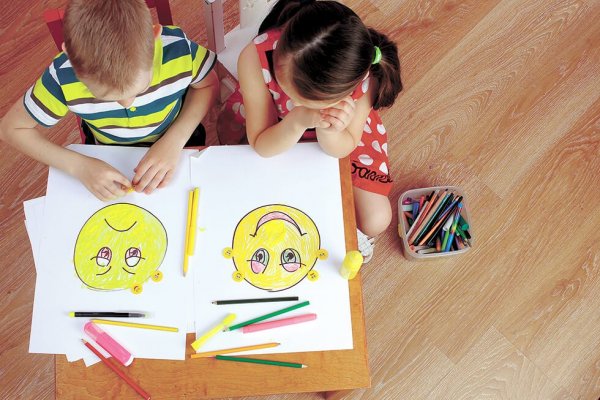Emotionary: A Wonderful Book About Emotional Education

Your emotional education plays a huge role in the person you become in life. Properly managing your emotions makes you more intelligent. But first, someone has to teach you how. One of the best new tools out there for that is the children’s book Emotionary: Say What You Feel.
The book is meant for kids (and their elders) as a way to help teach them to define their feelings and their causes and influences. On top of that, they’ll get to know themselves better, but they’ll also be quicker to empathize with others. The idea is that knowing how other people feel doesn’t just make you compassionate, it makes you intelligent.
“Knowing yourself is the beginning of all wisdom.”
-Aristotle-
What is emotional intelligence?
Emotional intelligence is defined as the ability to identify and manage your emotions. It also means taking advantage of that ability to channel your energy in a positive direction. It’s a skill that comes into play in every part of your social life. This isn’t the only area it plays an interesting role in, though. It also deals with things like your internal monologue and the thoughts you make room for.

Emotional intelligence isn’t a part of traditional psychology, though, and it’s a very new concept. It’s not a part of conventional intelligence tests. At the same time, a lot of people see it as the reason the IQ test is obsolete. IQ tests involve a different kind of intelligence, one that’s more analytical and logical. But developing that kind of intelligence doesn’t make you any better at dealing with your emotions.
That’s why tools that can help get people interested in emotional intelligence are so wonderful. One of the best ones is Emotionary.
What is Emotionary?
It’s a book in the form of a dictionary with 42 entries, one for everyone emotion:
| Love | Tenderness | Hate | Anger | Irritation | Tension |
| Relief | Calmness | Happiness | Joy | Sadness | Compassion |
| Remorse | Guilt | Embarrassment | Insecurity | Shyness | Confusion |
| Fear | Astonishment | Disgust | Hostility | Acceptance | Misunderstanding |
| Helplessness | Solitude | Nostalgia | Melancholy | Boredom | Excitement |
| Enthusiasm | Euphoria | Discouragement | Disappointment | Frustration | Admiration |
| Envy | Desire | Satisfaction | Pride | Pleasure | Gratefulness |
In the dictionary, every entry comes with a visual representation of the emotion and a short description of what that emotion is. There’s another important point they add in each entry: the causes, consequences, or other aspects of that emotion, in terms of the emotion after it.
The book is part of a project called Say What You Feel. The point of it is to explore the emotional world of children or even adults. Emotionary is just one part of this project. They also have a Gratitude Diary, activities, a reader guide, emotion workshops, and ideas for using the images in Emotionary.
Most of the resources from the project are available in Spanish, on the web page for Palabras Aladas.
How do you use Emotionary?
It’s a perfect book for kids 6 years and older. This is when they start to feel complex emotions. It wouldn’t be helpful at younger ages, because the content is too complex for them. But if you have the time and resources, it’s definitely adaptable if you want to start using it earlier.
They market Emotionary as a teaching tool for parents and educators. It’s great at home because it reinforces the bond between parents and their children through emotional understanding and communication. Teachers can also use it in schools because the extra materials can bring up questions, discussions, and idea exchange in the classroom.
Why is it such an important tool?
Whether you’re a parent, an educator, or just an adult who spends time around kids, Emotionary is a great tool. At home, it could be their nighttime reading. You can do it with them (which is good for your bond), or let them do it alone (which will stimulate their intrapersonal intelligence).

There’s an endless list of added material you can use in school with this book. Their website has free resources organized by educational level (kindergarten, elementary, middle, and high school). They’re worksheets with colorable drawings about all the different emotions. There are also simple questions, visualizations of emotions, and identifications of them through drawings and scenes.
Though it’s only in Spanish right now, the publisher even has a workshop to help little kids identify their emotions and express them with the right words.
Lastly, we want to emphasize that emotional intelligence is an ability we use to develop ourselves and our relationships. That’s why Emotionary can be such a great help. It shows how valuable emotions are and brings that information to small children.
Your emotional education plays a huge role in the person you become in life. Properly managing your emotions makes you more intelligent. But first, someone has to teach you how. One of the best new tools out there for that is the children’s book Emotionary: Say What You Feel.
The book is meant for kids (and their elders) as a way to help teach them to define their feelings and their causes and influences. On top of that, they’ll get to know themselves better, but they’ll also be quicker to empathize with others. The idea is that knowing how other people feel doesn’t just make you compassionate, it makes you intelligent.
“Knowing yourself is the beginning of all wisdom.”
-Aristotle-
What is emotional intelligence?
Emotional intelligence is defined as the ability to identify and manage your emotions. It also means taking advantage of that ability to channel your energy in a positive direction. It’s a skill that comes into play in every part of your social life. This isn’t the only area it plays an interesting role in, though. It also deals with things like your internal monologue and the thoughts you make room for.

Emotional intelligence isn’t a part of traditional psychology, though, and it’s a very new concept. It’s not a part of conventional intelligence tests. At the same time, a lot of people see it as the reason the IQ test is obsolete. IQ tests involve a different kind of intelligence, one that’s more analytical and logical. But developing that kind of intelligence doesn’t make you any better at dealing with your emotions.
That’s why tools that can help get people interested in emotional intelligence are so wonderful. One of the best ones is Emotionary.
What is Emotionary?
It’s a book in the form of a dictionary with 42 entries, one for everyone emotion:
| Love | Tenderness | Hate | Anger | Irritation | Tension |
| Relief | Calmness | Happiness | Joy | Sadness | Compassion |
| Remorse | Guilt | Embarrassment | Insecurity | Shyness | Confusion |
| Fear | Astonishment | Disgust | Hostility | Acceptance | Misunderstanding |
| Helplessness | Solitude | Nostalgia | Melancholy | Boredom | Excitement |
| Enthusiasm | Euphoria | Discouragement | Disappointment | Frustration | Admiration |
| Envy | Desire | Satisfaction | Pride | Pleasure | Gratefulness |
In the dictionary, every entry comes with a visual representation of the emotion and a short description of what that emotion is. There’s another important point they add in each entry: the causes, consequences, or other aspects of that emotion, in terms of the emotion after it.
The book is part of a project called Say What You Feel. The point of it is to explore the emotional world of children or even adults. Emotionary is just one part of this project. They also have a Gratitude Diary, activities, a reader guide, emotion workshops, and ideas for using the images in Emotionary.
Most of the resources from the project are available in Spanish, on the web page for Palabras Aladas.
How do you use Emotionary?
It’s a perfect book for kids 6 years and older. This is when they start to feel complex emotions. It wouldn’t be helpful at younger ages, because the content is too complex for them. But if you have the time and resources, it’s definitely adaptable if you want to start using it earlier.
They market Emotionary as a teaching tool for parents and educators. It’s great at home because it reinforces the bond between parents and their children through emotional understanding and communication. Teachers can also use it in schools because the extra materials can bring up questions, discussions, and idea exchange in the classroom.
Why is it such an important tool?
Whether you’re a parent, an educator, or just an adult who spends time around kids, Emotionary is a great tool. At home, it could be their nighttime reading. You can do it with them (which is good for your bond), or let them do it alone (which will stimulate their intrapersonal intelligence).

There’s an endless list of added material you can use in school with this book. Their website has free resources organized by educational level (kindergarten, elementary, middle, and high school). They’re worksheets with colorable drawings about all the different emotions. There are also simple questions, visualizations of emotions, and identifications of them through drawings and scenes.
Though it’s only in Spanish right now, the publisher even has a workshop to help little kids identify their emotions and express them with the right words.
Lastly, we want to emphasize that emotional intelligence is an ability we use to develop ourselves and our relationships. That’s why Emotionary can be such a great help. It shows how valuable emotions are and brings that information to small children.
This text is provided for informational purposes only and does not replace consultation with a professional. If in doubt, consult your specialist.







